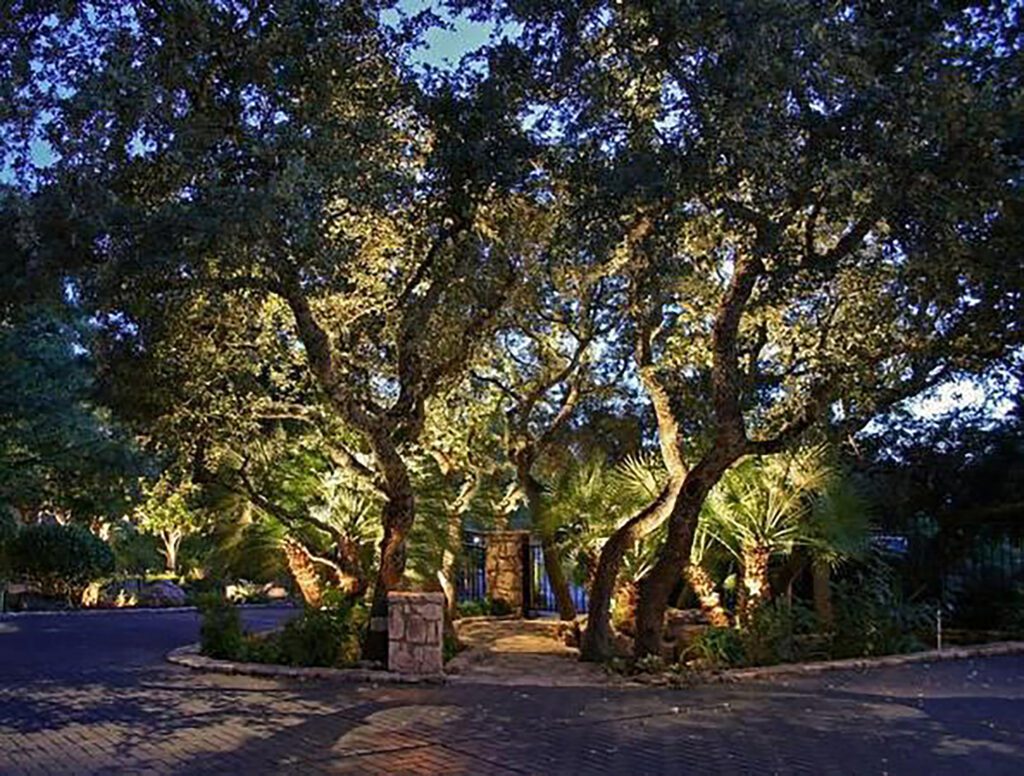Dark Sky Initiative
What is Dark Sky Compliance and Light Pollution?

A simple explanation is that light pollution is an overuse, and an inefficient use, of artificial light. Improving the quality of night lighting and has become a rallying cry of many municipal agencies, designers and environmental advocates concerned with sustainability and the environment. Light pollution is being addressed through many local and national initiatives. The main organization is The International Dark Sky Association.
For the purpose of this article, I will focus on our core business, residential landscape lighting. As our industry grows, we are seeing a continuing call for more sustainability (in addition to LED and lumens per watt). Light pollution happens when glare is not controlled, the wrong fixtures are installed or over lighting issues in general.
The most common source of light pollution is artificial light that goes where it is not intended to go. This is referred to light trespass. Light that trespasses in a horizontal pattern is known as glare. When too much light (over lighting) is used, it is often referred to as “light clutter.”
What is most concerning are two main factors: One being the personal effect on our health, wildlife and plant material. Second is the general interference of the night sky which can affect mood and our relationship with nature.
Wildlife Concerns-
The concerns for wildlife include habitat disturbance, wildlife behavior and wildlife survival. For example, artificial light contributes annually in North America, to an estimated one hundred million bird deaths, attributed to animals that are being entrapped by artificial light, affecting their navigation ability, long distance migration and disturbing natural mating habits that are crucial to “homeostasis and natural order.” In fact, many animals are nocturnal, so their survival depends on the darkness of night.
Human Concerns-
One third of all human food requires a pollinator or anything that helps carry pollen from the flower stamen (male) to the flower stigma (female). This includes both birds and insects. Light pollution also allows predator bugs to multiply which can cause damage to human communities and food sources.
Making Progress-
It is important to note that artificial light at night is a recent event; only in the past 120 years that artificial light has been part of our world. Compare this to 50,000 years without artificial light. With the help of government action, we are seeing improvements with new streetlighting that is fully shielded, timing and motion sensors to limit the total amount of use for practical purposes, improved energy efficient light sources and dimming at off peak hours. These initiatives also help reduce greenhouse gasses that result from wasted and inefficient lighting.
Here are the five principles for responsible residential outdoor lighting:
- All lights should have clear purpose. Design your lighting system to be intentional, ambient and task related as opposed to general lighting which can be glary, unnecessary and unattractive.
- Light should be targeted and directed only where it is needed. Use shielded fixtures (when possible).
- Light levels should be a variation of low-level intensity or a maximum of 5-foot candles per fixture. For example, a good outdoor lighting plan has three levels of illumination. Typically, lower level in the front, medium level in the center and higher levels in the back or rear of the property. This allows for visual comfort and layering to the night scene.
- Controllers should be used to provide the proper light when needed. This includes, timers, photo cells, motion sensors and dimmers.
- Warm color tones offer better sustainability. Many initiatives suggest kelvin temperatures between 2200-3500k, depending on local codes.
Summary-
It may not always be practical to provide a total dark sky system but it is important to consider the elements, natural habitats and visual comfort. Here are the important take-aways for Dark Sky compliance: - Outdoor and landscape lighting should be a high-quality LED with a minimum lumen to watt ratio of 80 lumens per watt (L/W) and a maximum of 5-foot candles per fixture. In general, the recommended kelvin temperatures should be below 3500k. If the fixture is not directed downward, each luminaire should have a cut off or shielded glare control. Up lighting should be soft and targeted. Down lighting should be aimed at a maximum of 30 degrees to avoid glare.
- Be mindful of the neighborhood. Consider lighting trespass that could fall outside of the property. Excessive eye glare can be as annoying as excessive noise to the ears.
- Dark sky compliance is a designation given to outdoor lighting fixtures, usually defined by the municipality in which the lighting is to be installed, that meets specific requirements to minimize light pollution, light trespass and offensive light sources. Check with local lighting ordinances for municipal codes. For general questions, check out The International Dark Sky Association. This agency also offers an FSA or fixture seal of approval for commercial properties as well as some multi-family/multi use properties.
- Although most residential projects do not require Dark Sky FSA, the premise of dark sky compliance should be considered for visual comfort and being respectful to neighbors, the surrounding environment and natural habitats.
